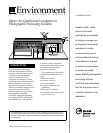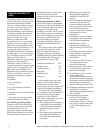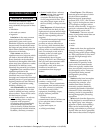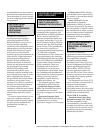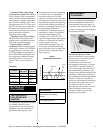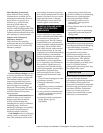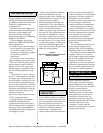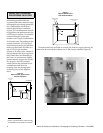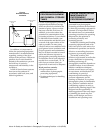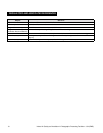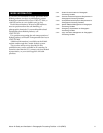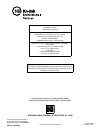
Indoor Air Quality and Ventilation in Photographic Processing Facilities • J-314(ENG) 5
Direct Reading
These are measurement techniques
that can immediately indicate the
concentration of aerosols, gases, or
vapors by some means such as a dial
or meter or noting the color change of
an indicator chemical.
Colorimetric Detector Tubes
Several colorimetric, direct reading
detector tubes are useful for quick
assessments of airborne
contaminants associated with
photographic processing. A special
pump draws a specific volume of
room air through a detector tube. If
the contaminant is present, a color
change occurs along the length of the
tube that is directly proportional to
the concentration of the contaminant
in the air. Tubes are available for
acetic acid, sulfur dioxide, ammonia,
and many other gases and vapors.
The tubes are easy to use and
generally have an accuracy of ± 25%.
Other chemicals in the air may
interfere with the accuracy and
sensitivity of the tubes.
MEASUREMENT
TECHNIQUES
Threshold Limit Value-Short-
Term Exposure Limit (TLV-STEL):
The 15-minute TWA concentration
which should not be exceeded at any
time during a workday even if the 8-
hour TWA is within the TLV-TWA.
Exposure above the TLV-TWA up to
the STEL should not be longer than
15 minutes and should not occur
more than four times per day with at
least 60 minutes in between
exposures in this range.
Threshold Limit Value-Ceiling
(TLV-C): The concentration that
should not be exceeded during any
part of the working exposure.
OSHA Limits vs ACGIH
Guidelines: OSHA limits are legally
enforceable, whereas ACGIH limits
are guidelines. In most cases, the
ACGIH guidelines are the same or
lower than OSHA limits (there are a
few exceptions). When the values
are not the same, it is prudent to
follow the lower, more conservative
value.
Examples:
Air samples are sometimes collected
to evaluate potential worker
exposure levels for comparison to
published exposure standards or
guidelines. The purpose of the
Chemical
OSHA
PEL 8-hour
ACGIH
TLV 8-hour
Acetic acid 10 ppm 10 ppm
Ammonia 50 ppm 25 ppm
Formaldehyde 0.75 ppm 0.3 ppm
(ceiling)
Sulfur dioxide 5 ppm 2 ppm
METHODS OF
EVALUATION
THE PURPOSE OF
COLLECTING AIR
SAMPLES
measurement may vary depending
on whether you are interested in
short-term exposure, full shift
exposure, or the exposure incurred
during a specific step or process. The
measurements represent a sampling
of the actual working conditions at
the time of sampling. Generally, the
more sampling data that are
available for a certain job/process/
task under a variety of conditions,
the better understanding and
confidence you will have in the
exposure measurements during that
process. As illustrated in Figure 1,
actual exposure can vary
substantially during the day. In
some cases, full-shift monitoring
may be the goal while in others, the
goal may be to understand short-
term exposure.
Figure 1
Typical Exposure Scenario
Basic Definitions
Sensitivity or Precision: how
reproducible is the sampling
method.
Accuracy: how close to the true value
is the sampling method.
Avg.
8-hr
Actual
OSHA PEL
4pm2pmNoon10am8am
Concentration (ppm)



